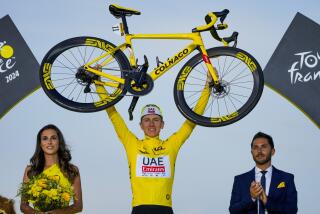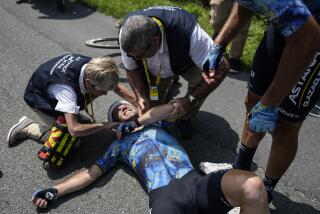Tour de France Route Is Right Up His Alley : Race’s Six Mountain Stages Are Expected to Benefit Rested Hampsten
- Share via
Last year, Andrew Hampsten became the first U.S. cyclist to win the Tour of Italy, but then finished a disappointing 16th in the Tour de France three weeks later.
Why?
Hampsten, 27, thinks he knows.
He said that traveling from Italy back to the United States and then to France left him too tired for the Tour de France, the world’s most prestigious bicycle race.
So this year, Hampsten, of Boulder, Colo., didn’t come back after finishing third in the recent Tour of Italy. He stayed in Brussels with Eddy Merckx, the retired Belgian cyclist who won the tour five times, and hopes that the relaxation will give him an advantage in this year’s 1,996-mile, 22-day race, which begins Saturday.
“The traveling exhausted me more than the race,” Hampsten said from Brussels about last year’s regimen.”I’ve recovered well this year.”
Last year, Hampsten said, he started the Italian race in good shape. This year, he said, he found his form during the race. That might not be the way to win the Tour of Italy, but it is excellent preparation for France, he added.
Hampsten is among the strong contenders in the 76th tour, which will feature four former winners. The race will start in Luxembourg and take a counterclockwise route around eastern and southern France, ending July 23 in the center of Paris with a sprint from Versailles.
Hampsten believes this year’s race, during the bicentennial celebration of the French Revolution, has been designed to his advantage because it has six mountain stages, two more than last year.
Hampsten showed himself to be a strong climber when he won the mountain stage in the 1985 Tour of Italy, his first pro race.
“The harder the race is in the mountains, the better for me,” Hampsten said, adding that he can distance himself from the faster riders who thrive on the flats.
But no matter how strong Hampsten rides through the Pyrenees and Alps, he has little chance of winning the coveted maillot jaune , the yellow jersey signifying the first-place rider, without help from his 7-Eleven teammates.
Although the Tour de France often focuses on individuals, it is a team event, Hampsten said. His team qualified this year for one of four wild-card berths, and Hampsten believes he has strong riders with him, despite the loss of Raul Alcala to the PDM racing squad. Alcala, 25, the first Mexican to compete in the Tour de France, finished ninth overall in 1987.
“We don’t need a lot of stars,” Hampsten said.
Team members support their leading rider by blocking potential challengers or supplying a spare tire, often at the expense of their own success. The last beneficiary of the 7-Eleven team effort was Dag Otto Lauritzen of Norway, who won the inaugural Tour de Trump in May.
“We work for whoever is strongest,” Hampsten said.
Hampsten and his teammates will have a difficult task with four former tour winners--Pedro Delgado of Spain, Laurent Fignon of France, Stephen Roche of Ireland and Greg LeMond of Rancho Murietta, Calif., and Wayzata, Minn., competing.
Delgado will be the first defending champion to return since 1986, when Bernard Hinault of France lost to his teammate, LeMond, the first--and only--U.S. rider to win the tour.
Delgado, who won the Tour of Spain is, like Hampsten,
an expert mountain racer who won last year’s race through the steep mountain passes of the Alps.
Roche, who returned from a 1985 knee injury and won the 1987 tour, was unable to race last year because of injuries. He defeated Delgado in a close duel in 1987 and has performed well this year.
However, Roche’s team, Fagor, is not considered strong.
Fignon, a two-time French winner, won the Tour of Italy three weeks ago.
As successful as he has been, Fignon, a Systeme U rider, has been plagued by injuries in recent years. He missed the 1985 tour after having surgery on his left heel for tendinitis. In 1986, he suffered a broken collarbone in a racing accident. The Tour of Italy was Fignon’s first major victory since the 1984 Tour de France, in which he defeated Hinault by more than 10 minutes.
LeMond, unable to race in 1987 after a near-fatal hunting accident, also is making a comeback.
Now a member of the ADR/Coors Light team, LeMond missed most of 1988 because of tendinitis and this year’s tour will be his first since his 1986 victory.
LeMond has had difficulties this year including the Tour de Trump where he finished far back because of illness. However, he finished strongly in the final time trial at the Tour of Italy, an indication that he should not be counted out.
Most observers, however, believe that the United States’ hopes ride with Hampsten.
More to Read
Sign up for Essential California
The most important California stories and recommendations in your inbox every morning.
You may occasionally receive promotional content from the Los Angeles Times.













